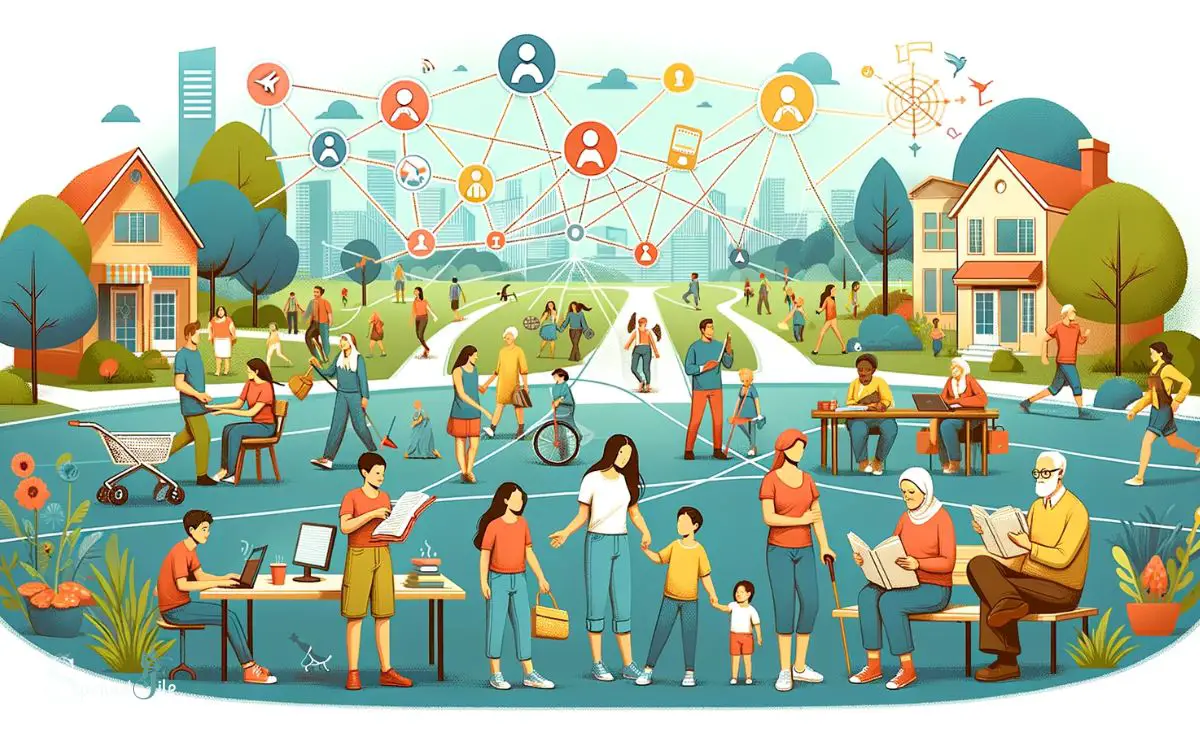Spiritual Partnership Vs Marriage: Mutual Growth!
Spiritual partnerships and traditional marriages are two distinct forms of intimate relationships that cater to different aspects of human connection.
While marriage is a legally and socially recognized union between two individuals, a spiritual partnership focuses on mutual growth, emotional support, and shared values beyond legal bindings.
Both can be fulfilling but serve different purposes in one’s personal development and quest for companionship.
Spiritual partnerships are based on the notion of two individuals coming together primarily for the purpose of spiritual and personal growth.
They tend to prioritize emotional connection and the evolution of the soul or consciousness. These partnerships are not defined by legal or traditional boundaries but by the mutual commitment to support each other’s spiritual journey.
For example, two people in a spiritual partnership may not be legally married but could live together and be committed to each other in every way that a married couple would, with the added emphasis on spiritual practices like meditation, mindfulness, or joint exploration of faith.
Traditional marriage, on the other hand, is a legally recognized union that often includes spiritual elements but also encompasses social, economic, and legal dimensions.
It creates a formally acknowledged framework for the relationship, which can involve shared property rights, next-of-kin status, and other societal benefits.
- Legal status: Marriage offers legal recognition, while spiritual partnerships may not.
- Focus: Spiritual partnerships emphasize spiritual growth, while marriages may focus on broader aspects of life together.
- Social recognition: Marriage is widely recognized and accepted socially, whereas spiritual partnerships may not have the same level of social validation.
Choosing between a spiritual partnership and marriage is a deeply personal decision that reflects one’s values and desires for growth within a relationship.
Both paths offer unique opportunities for love and evolution, shaped by the intentions and commitments of the individuals involved.

Key Takeaway
4 Aspects: Spiritual Partnership Vs Marriage
| Aspect | Spiritual Partnership | Marriage |
|---|---|---|
| Nature | Spiritual and emotional | Legal and social contract |
| Commitment | Emphasis on spiritual connection | Legal obligations and vows |
| Recognition | Non-legal, spiritual bond | Legally recognized union |
| Roles and Rights | Defined by spiritual values | Governed by legal rights |
Historical Context

The historical context of spiritual partnership and marriage reveals significant shifts in societal norms and values over time.
In ancient civilizations, marriage was often an economic or political arrangement, with little emphasis on personal choice or spiritual connection.
As societies evolved, religious institutions began to play a central role in formalizing marriage, infusing it with spiritual significance.
Over time, the concept of spiritual partnership emerged as a more egalitarian and emotionally connected alternative to traditional marriage.
This shift was influenced by changing views on individual autonomy, gender equality, and the pursuit of personal fulfillment.
Today, the historical context of spiritual partnership and marriage reflects an ongoing tension between tradition and modernity, as individuals seek relationships that honor both spiritual and personal growth within the ever-changing landscape of societal values.
Legal and Social Expectations

In the evolving landscape of societal values, legal and social expectations regarding spiritual partnership and marriage have undergone notable transformations.
Traditional legal frameworks have primarily focused on marriage, offering specific rights and responsibilities to spouses.
However, in recent years, there has been a growing recognition of spiritual partnerships, with legal systems in some jurisdictions beginning to acknowledge and provide legal recognition and protections for these relationships.
Social expectations have also evolved, with an increasing acceptance of diverse relationship structures beyond traditional marriage.
This shift reflects a broader societal understanding of the complexity and diversity of human relationships, emphasizing the importance of mutual respect, support, and commitment, regardless of the specific form the partnership takes.
As societal values continue to evolve, legal and social expectations are likely to further adapt to accommodate the changing landscape of relationships.
Emotional and Spiritual Connection
Amidst the shifting landscape of relationship dynamics, emotional and spiritual connection plays a pivotal role in both spiritual partnerships and traditional marriages.
Emotional connection involves the ability to understand, empathize, and communicate with one’s partner on a deep level, fostering trust and intimacy.

In spiritual partnerships, this connection often extends beyond the individual and encompasses a shared sense of purpose, growth, and alignment with universal principles.
Similarly, in traditional marriages, couples seek emotional support and understanding from each other while navigating life’s challenges.
Spiritual connection, on the other hand, involves shared values, beliefs, and a sense of unity that transcends the physical realm. It can provide a profound sense of meaning, grounding, and harmony within the relationship.
Both types of connections are essential for fostering a fulfilling and enduring bond in any intimate relationship.
Communication and Conflict Resolution
Communication and conflict resolution are integral components of both spiritual partnerships and traditional marriages, shaping the dynamics and longevity of intimate relationships.
In spiritual partnerships, communication goes beyond verbal expression, encompassing deep listening and empathy.
Conflict resolution in spiritual partnerships often involves a shared commitment to personal growth and the relationship’s evolution.

It emphasizes understanding the root cause of conflicts and transforming them into opportunities for mutual learning and connection.
Traditional marriages, on the other hand, may rely more on established communication patterns and formal conflict resolution strategies. These often involve compromise and negotiation to reach mutually acceptable solutions.
Both spiritual partnerships and traditional marriages benefit from open, respectful communication and proactive conflict resolution, fostering trust, emotional intimacy, and the overall health of the relationship.
Roles and Responsibilities

Now let’s turn our attention to the crucial aspects of roles and responsibilities within spiritual partnership and marriage.
This includes the importance of equality in shared duties, the dynamics of division of household chores, and the financial management dynamics that play a significant role in both types of relationships.
These points form the foundation for a deeper understanding of how roles and responsibilities are navigated within these different relationship structures.
Equality in Shared Duties
How can couples ensure equal distribution of duties and responsibilities in their spiritual partnership or marriage?
Achieving equality in shared duties requires open communication and mutual respect. Start by having an honest conversation about each person’s strengths, preferences, and availability.
Consider creating a list of all the tasks that need to be done and then divide them based on each person’s abilities and interests. It’s important to be flexible and willing to adjust the division of duties as needed.
Remember that equality doesn’t always mean splitting everything 50/50; it means finding a balance that works for both partners. Regularly reassess the distribution of responsibilities to ensure that both partners feel valued and respected.
Division of Household Chores
In a spiritual partnership or marriage, the division of household chores involves delineating specific roles and responsibilities to ensure a harmonious and balanced home environment.
This division should be based on the strengths and preferences of each partner, as well as the practical needs of the household.
It is important to have open and honest communication to discuss and agree upon the distribution of tasks. Flexibility and willingness to adapt to changing circumstances are also crucial in maintaining a fair division of household chores.
Additionally, recognizing and appreciating each other’s contributions can foster a sense of teamwork and mutual support.
Ultimately, the goal is to create a nurturing and supportive home environment where both partners feel valued and respected for their contributions to the shared responsibilities.
Financial Management Dynamics
Financial management dynamics within a spiritual partnership or marriage involve the careful delineation of roles and responsibilities to ensure a balanced and transparent approach to monetary matters.
This includes:
Primary Breadwinner:
- The individual responsible for the majority of the income generation.
- Takes the lead in long-term financial planning and investment decisions.
Financial Administrator:
- Manages daily financial tasks such as bill payments, budgeting, and tracking expenses.
- Collaborates with the primary breadwinner to ensure financial goals are aligned and met.
It’s crucial for partners to openly communicate and establish these roles based on individual strengths and preferences.
This fosters trust and understanding, leading to a harmonious financial partnership. Such dynamics lay the foundation for mutual growth and personal development within the relationship.
Growth and Personal Development

A key aspect of growth and personal development within a spiritual partnership or marriage is the commitment to individual and joint evolution.
Both partners must be dedicated to their personal growth while also supporting each other’s development.
This commitment often involves open communication, self-reflection, and a willingness to embrace change.
In the context of a spiritual partnership or marriage, this mutual dedication to growth fosters an environment where both individuals can flourish, both independently and as a couple.
| Personal Growth | Joint Evolution |
|---|---|
| Self-awareness | Shared goals |
| Emotional maturity | Collaborative learning |
| Self-improvement | Mutual support |
| Spiritual development | Relationship growth |
| Intellectual expansion | Communication enhancement |
This shared commitment to individual and joint evolution forms a solid foundation for the subsequent exploration of intimacy and commitment within a spiritual partnership or marriage.
Intimacy and Commitment

As we explore the dynamics of spiritual partnership versus traditional marriage, it becomes essential to consider the aspects of intimacy and commitment.
This entails understanding the emotional depth in partnership, the mutual growth and connection that underpin it, and the sacredness of the shared journey.
These points form the foundation for a deeper examination of the differences and similarities in the realms of intimacy and commitment between spiritual partnership and marriage.
Emotional Depth in Partnership
An essential component of a spiritual partnership is fostering a deep emotional intimacy and unwavering commitment to each other’s growth and well-being.
This involves:
- Emotional Intimacy
- Cultivating open and honest communication to create a safe space for vulnerability and understanding.
- Prioritizing active listening and empathy to deeply connect with each other’s feelings and experiences.
This emotional depth forms the foundation for the partnership’s strength and resilience, allowing both individuals to support and uplift one another through life’s challenges and triumphs. It sets the stage for mutual growth and connection, which will be explored in the subsequent section.
Mutual Growth and Connection
Building on the foundation of emotional intimacy, the mutual growth and connection in a spiritual partnership is characterized by a deep commitment to each other’s development and a shared pursuit of spiritual and personal evolution.
This type of connection goes beyond traditional notions of intimacy and commitment in a marriage, as it emphasizes the growth and evolution of both individuals within the partnership.
It involves supporting each other’s aspirations, encouraging personal and spiritual development, and fostering an environment where both partners can flourish.
This level of mutual growth and connection fosters a deep sense of understanding, trust, and shared purpose within the partnership. It is a bond that transcends the conventional aspects of a relationship, creating a space for both individuals to thrive and evolve together.
Sacredness of Shared Journey
Emphasizing the sacredness of their shared journey, a spiritual partnership fosters a profound intimacy and commitment grounded in a mutual pursuit of spiritual and personal growth.
This depth of connection is characterized by:
- Spiritual Intimacy: Engaging in deep, meaningful conversations about spiritual beliefs and experiences, creating an environment for vulnerability and trust.
- Commitment to Growth: Supporting each other’s individual journeys, while also committing to the growth and evolution of the partnership as a unified entity.
This shared journey is sacred, as it involves the intertwining of two individuals’ spiritual paths, creating a space for mutual understanding, respect, and support.
Such depth of intimacy and commitment forms the foundation of a spiritual partnership, setting it apart from traditional marital relationships.
Now, let’s explore the challenges and opportunities inherent in this unique form of partnership.
Challenges and Opportunities

In considering the challenges and opportunities of spiritual partnership versus marriage, it is essential to recognize the potential for growth and transformation within both relationship structures.
Both spiritual partnership and marriage offer unique opportunities for individuals to evolve emotionally, spiritually, and mentally.
However, they also present distinct challenges that require conscious effort and understanding to navigate.
Below is a table illustrating some of the key challenges and opportunities associated with spiritual partnership and marriage.
| Aspect | Spiritual Partnership | Marriage |
|---|---|---|
| Growth Opportunities | Emphasis on individual and joint spiritual development | Opportunity for personal growth within unity |
| Communication Challenges | Open, honest, and deep communication | Navigating communication styles and expectations |
| Shared Responsibilities | Shared based on individual strengths and inclinations | Traditional roles or negotiated responsibilities |
| Conflict Resolution | Emphasis on spiritual alignment and understanding | Balancing individual needs with compromise |
| Commitment | Based on spiritual growth and connection | Legally binding commitment with societal norms |
What Is the Difference Between a Spiritual Partnership and a Traditional Marriage in Terms of Mutual Growth?
In a spiritual union and marriage, mutual growth focuses on spiritual evolution and personal development, while traditional marriage may prioritize societal norms and expectations. A spiritual partnership emphasizes connection at a deeper level, whereas a traditional marriage may focus more on practical aspects and external factors.
FAQ About Spiritual Partnership Vs Marriage
How Does the Concept of Spiritual Partnership Differ From Traditional Marriage in Terms of Societal Expectations and Norms?
The concept of spiritual partnership differs from traditional marriage in terms of societal expectations and norms by emphasizing a deeper connection and shared purpose over conventional roles and legal obligations.
Can a Spiritual Partnership Still Provide Legal Protections and Benefits Similar to Those of Marriage?
Yes, a spiritual partnership can provide legal protections and benefits similar to those of marriage through legal contracts such as a cohabitation agreement, durable power of attorney, healthcare proxy, and wills.
These documents can help establish rights and protections for partners.
How Can Couples in a Spiritual Partnership Navigate Cultural and Religious Expectations Surrounding Marriage?
Couples in a spiritual partnership can navigate cultural and religious expectations surrounding marriage by open communication, seeking guidance from spiritual leaders or mentors.
What Are the Unique Communication and Conflict Resolution Challenges That May Arise in a Spiritual Partnership Compared to a Traditional Marriage?
In a spiritual partnership, unique communication and conflict resolution challenges may arise, distinct from those in traditional marriage.
These challenges often stem from differing spiritual beliefs, values, and practices, requiring thoughtful and compassionate dialogue for resolution.
In What Ways Does a Spiritual Partnership Allow for Greater Personal Growth and Development Compared to a Traditional Marriage?
A spiritual partnership allows for greater personal growth and development compared to a traditional marriage through its emphasis on mutual support, deep connection, and shared spiritual practices.
This can lead to individual and collective transformation.
Conclusion
The comparison between spiritual partnership and marriage reveals the complex intertwining of legal, emotional, and spiritual aspects.
Both relationships present opportunities for growth and personal development, as well as challenges in communication and conflict resolution.
The choice between the two reflects the individual’s values and beliefs, and the willingness to pursue a deeper connection.
As we navigate these relationships, we are reminded of the timeless quest for love, understanding, and fulfillment in our lives.






